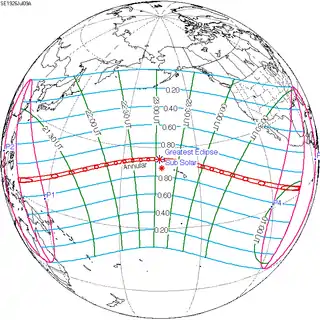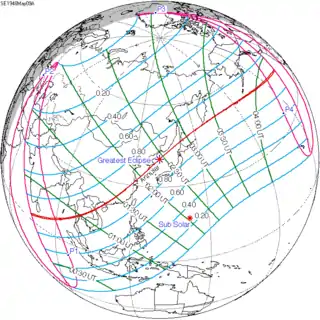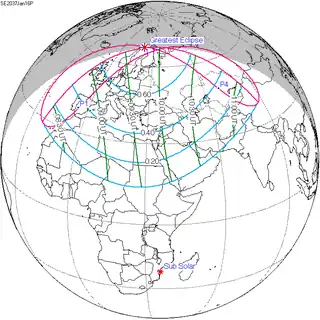| Solar eclipse of March 31, 2090 | |
|---|---|
 Map | |
| Type of eclipse | |
| Nature | Partial |
| Gamma | −1.1028 |
| Magnitude | 0.7843 |
| Maximum eclipse | |
| Coordinates | 72°06′S 156°18′W / 72.1°S 156.3°W |
| Times (UTC) | |
| Greatest eclipse | 3:38:08 |
| References | |
| Saros | 150 (21 of 71) |
| Catalog # (SE5000) | 9710 |
A partial solar eclipse will occur on March 31, 2090. A solar eclipse occurs when the Moon passes between Earth and the Sun, thereby totally or partly obscuring the image of the Sun for a viewer on Earth. A partial solar eclipse occurs in the polar regions of the Earth when the center of the Moon's shadow misses the Earth.
Related eclipses
Solar eclipses 2087–2090
This eclipse is a member of a semester series. An eclipse in a semester series of solar eclipses repeats approximately every 177 days and 4 hours (a semester) at alternating nodes of the Moon's orbit.[1]
| 120 | May 2, 2087 Partial |
125 | October 26, 2087 Partial |
| 130 | April 21, 2088 Total |
135 | October 14, 2088 Annular |
| 140 | April 10, 2089 Annular |
145 | October 4, 2089 Total |
| 150 | March 31, 2090 Partial |
155 | September 23, 2090 Total |
Saros 150
It is a part of Saros cycle 150, repeating every 18 years, 11 days, containing 71 events. The series started with partial solar eclipse on August 24, 1729. It contains annular eclipses from April 22, 2126 through June 22, 2829. There are no total eclipses in this series. The series ends at member 71 as a partial eclipse on September 29, 2991. The longest duration of annularity will be 9 minutes, 58 seconds on December 19, 2522.
| Series members 11-21 occur between 1901 and 2100: | ||
|---|---|---|
| 11 | 12 | 13 |
 December 12, 1909 |
 December 24, 1927 |
 January 3, 1946 |
| 14 | 15 | 16 |
 January 14, 1964 |
 January 25, 1982 |
 February 5, 2000 |
| 17 | 18 | 19 |
 February 15, 2018 |
 February 27, 2036 |
 March 9, 2054 |
| 20 | 21 | |
 March 19, 2072 |
 March 31, 2090 | |
Tritos series
This eclipse is a part of a tritos cycle, repeating at alternating nodes every 135 synodic months (≈ 3986.63 days, or 11 years minus 1 month). Their appearance and longitude are irregular due to a lack of synchronization with the anomalistic month (period of perigee), but groupings of 3 tritos cycles (≈ 33 years minus 3 months) come close (≈ 434.044 anomalistic months), so eclipses are similar in these groupings.
| Series members between 1901 and 2100 | |||
|---|---|---|---|
 September 9, 1904 (Saros 133) |
 August 10, 1915 (Saros 134) |
 July 9, 1926 (Saros 135) | |
 June 8, 1937 (Saros 136) |
 May 9, 1948 (Saros 137) |
 April 8, 1959 (Saros 138) | |
 March 7, 1970 (Saros 139) |
 February 4, 1981 (Saros 140) |
 January 4, 1992 (Saros 141) | |
 December 4, 2002 (Saros 142) |
 November 3, 2013 (Saros 143) |
 October 2, 2024 (Saros 144) | |
 September 2, 2035 (Saros 145) |
 August 2, 2046 (Saros 146) |
 July 1, 2057 (Saros 147) | |
 May 31, 2068 (Saros 148) |
 May 1, 2079 (Saros 149) |
 March 31, 2090 (Saros 150) | |
Metonic cycle
The metonic series repeats eclipses every 19 years (6939.69 days), lasting about 5 cycles. Eclipses occur in nearly the same calendar date. In addition, the octon subseries repeats 1/5 of that or every 3.8 years (1387.94 days).
| 21 eclipse events between June 12, 2029 and June 12, 2105 | ||||
|---|---|---|---|---|
| June 11–12 | March 30–31 | January 16 | November 4–5 | August 23–24 |
| 118 | 120 | 122 | 124 | 126 |
 June 12, 2029 |
 March 30, 2033 |
 January 16, 2037 |
 November 4, 2040 |
 August 23, 2044 |
| 128 | 130 | 132 | 134 | 136 |
 June 11, 2048 |
 March 30, 2052 |
 January 16, 2056 |
 November 5, 2059 |
 August 24, 2063 |
| 138 | 140 | 142 | 144 | 146 |
 June 11, 2067 |
 March 31, 2071 |
 January 16, 2075 |
 November 4, 2078 |
 August 24, 2082 |
| 148 | 150 | 152 | 154 | |
 June 11, 2086 |
 March 31, 2090 |
 January 16, 2094 |
 November 4, 2097 | |
References
- ↑ van Gent, R.H. "Solar- and Lunar-Eclipse Predictions from Antiquity to the Present". A Catalogue of Eclipse Cycles. Utrecht University. Retrieved 6 October 2018.
External links
- Earth visibility chart and eclipse statistics Eclipse Predictions by Fred Espenak, NASA/GSFC
.jpg.webp)

